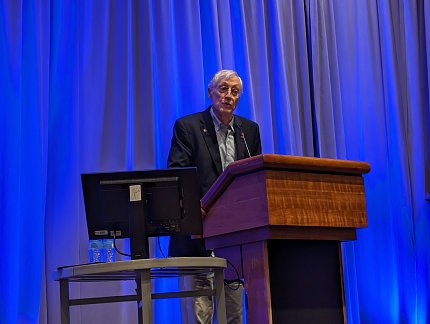Nobel Prize-Winning Astrophysicist Speaks at NIAMS Retreat

Photo: Greg Lavine
Physicists peering outward to the farthest reaches of the universe and biologists seeking to capture details of the tiniest molecules share more in common than one might think.
A Nobel Prize-winning physicist from the National Aeronautics and Space Administration (NASA) spoke to a NIAMS audience and explained that investigating the mysteries of life is a thread that connects both scientific fields.
Dr. John C. Mather, a NASA senior astrophysicist, was a keynote speaker at a recent National Institute of Arthritis and Musculoskeletal Diseases (NIAMS) Intramural Research Program (IRP) event that convened established researchers and trainees.
Traditionally, the NIAMS IRP invites speakers from various fields to expose NIAMS scientists to other disciplines and, this year, Mather was one of several.
“Where do we come from?” said Mather, as he thought back to some of his earliest philosophical questions. “What does ‘we’ mean? What is a human being? Is life a miracle?”
When it comes to speculating about the rarity of life in the universe, the space science community is leaning toward an interesting observation.
“Some scientists are starting to describe life as a thermodynamic imperative. Life will always occur when given a chance,” he said.
In the late 1960s, when Mather was an undergraduate at Swarthmore College, scientists were learning about the mystery of the universe’s composition. Researchers had recently made a seminal discovery that cosmic background radiation filled what was once thought to be empty space.
Scientists like Mather wanted to analyze the visible and non-visible spectrum to gather clues about the universe. Different spectrums, for example, could reveal chemical reactions happening in distant worlds.
At the University of California at Berkeley, Mather’s 1973 Ph.D. thesis documented his efforts to measure the cosmic spectrum. His team launched a high-altitude balloon, but it failed to gather the needed data.
A year later, NASA put out a call for satellite research proposals. Mather dusted off his thesis and revised the plan to take readings from orbit.
The plan became NASA’s Cosmic Background Explorer Satellite (COBE), which ultimately involved more than 1,500 people to get off the ground. The satellite launched in 1989 and the data it collected supports the Big Bang theory of how the universe began.
Mather later served as the senior project scientist for NASA’s James Webb Space Telescope, launched in 2021. The Webb telescope carried more advanced sensors that offered even clearer views of what is out there in the universe.
For each project, Mather stressed how much he relied on the expertise of thousands of colleagues, and that he could not fully understand all aspects of the project. He said he sees that same spirit of teamwork in the biomedical research field.
“I am impressed by seeing the progress about what is now possible in biology,” he noted.
While Mather will leave the biology to the biomedical experts, he and his colleagues will continue to look to the stars to solve their own mysteries—perhaps someday including the origins of life.
